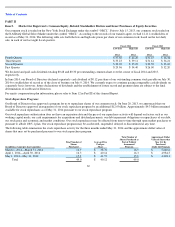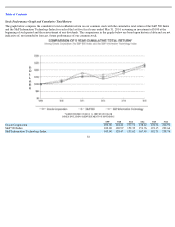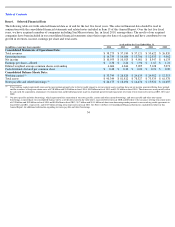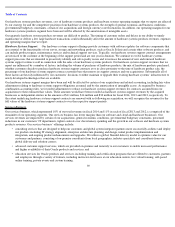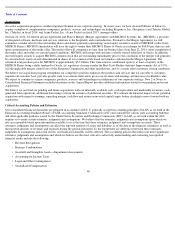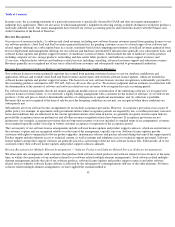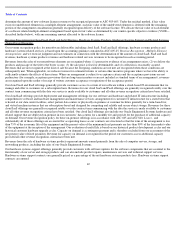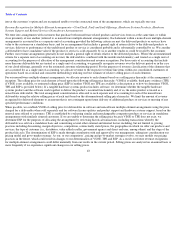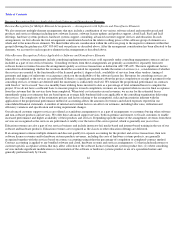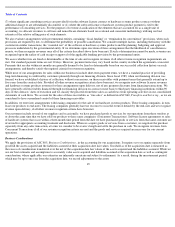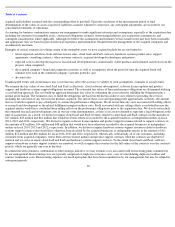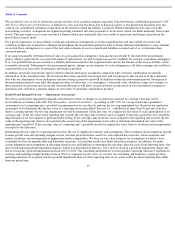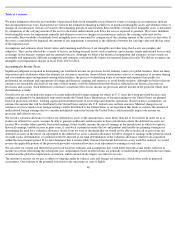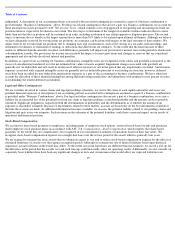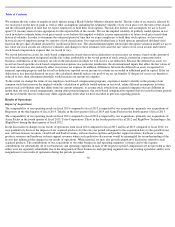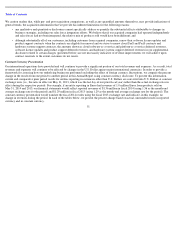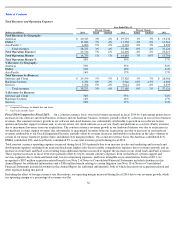Oracle 2013 Annual Report Download - page 46
Download and view the complete annual report
Please find page 46 of the 2013 Oracle annual report below. You can navigate through the pages in the report by either clicking on the pages listed below, or by using the keyword search tool below to find specific information within the annual report.
Table of Contents
determine the amount of new software license revenues to be recognized pursuant to ASC 985-605. Under the residual method, if fair value
exists for undelivered elements in a multiple-element arrangement, such fair value of the undelivered elements is deferred with the remaining
portion of the arrangement consideration generally recognized upon delivery of the software license. We allocate the fair value of each element
of a software related multiple-element arrangement based upon its fair value as determined by our vendor specific objective evidence (VSOE—
described further below), with any remaining amount allocated to the software license.
Revenue Recognition for Cloud SaaS, PaaS and IaaS Offerings, Hardware Systems Products, Hardware Systems Support and Related Services
(Nonsoftware Elements)
Our revenue recognition policy for nonsoftware deliverables including cloud SaaS, PaaS and IaaS offerings, hardware systems products and
hardware systems related services is based upon the accounting guidance contained in ASC 605-25, Revenue Recognition , Multiple-Element
Arrangements,
and we exercise judgment and use estimates in connection with the determination of the amount of cloud SaaS, PaaS and IaaS
revenues, hardware systems products revenues and hardware related services revenues to be recognized in each accounting period.
Revenues from the sales of our nonsoftware elements are recognized when: (1) persuasive evidence of an arrangement exists; (2) we deliver the
products and passage of the title to the buyer occurs; (3) the sale price is fixed or determinable; and (4) collection is reasonably assured.
Revenues that are not recognized at the time of sale because the foregoing conditions are not met are recognized when those conditions are
subsequently met. When applicable, we reduce revenues for estimated returns or certain other incentive programs where we have the ability to
sufficiently estimate the effects of these items. Where an arrangement is subject to acceptance criteria and the acceptance provisions are not
perfunctory (for example, acceptance provisions that are long-term in nature or are not included as standard terms of an arrangement), revenues
are recognized upon the earlier of receipt of written customer acceptance or expiration of the acceptance period.
Our cloud SaaS and PaaS offerings generally provide customers access to certain of our software within a cloud-based IT environment that we
manage and offer to customers on a subscription basis. Revenues for our cloud SaaS and PaaS offerings are generally recognized ratably over the
contract term commencing with the date our service is made available to customers and all other revenue recognition criteria have been satisfied.
Our cloud IaaS offerings provide deployment and management offerings for our software and hardware and related IT infrastructure including
comprehensive software and hardware management and maintenance services arrangements for customer IT infrastructure for a stated term that
is hosted at our data center facilities, select partner data centers or physically on-premise at customer facilities generally for a term-based fee;
and virtual machine instances that are subscription-based and designed for computing and reliable and secure object storage. Revenues for these
cloud IaaS offerings are generally recognized ratably over the contract term commencing with the date the service is made available to customers
and all other revenue recognition criteria have been satisfied. Our cloud IaaS offerings also include our Oracle Engineered Systems hardware and
related support that are deployed on-premise in our customers’ data centers for a monthly fee and provide for the purchase of additional capacity
on demand. Our revenue recognition policy for these on-premise offerings is in accordance with ASC 605 and ASC 840, Leases , and
substantially all of these offerings are accounted for as operating leases as our contracts are structured so that the term of the arrangement is less
than 75% of the economic life of the equipment and the present value of the minimum fixed payments are less than 90% of the fair market value
of the equipment at the inception of the arrangement. Our evaluation of useful life is based on our historical product development cycles and our
historical customer hardware upgrade cycles. Capacity on demand is a contingent payment and is therefore excluded from our assessment of the
net present value of fixed payments. Revenue for capacity on demand is recognized in the period our customers access additional capacity
provided all other revenue recognition criteria have been met.
Revenues from the sale of hardware systems products represent amounts earned primarily from the sale of computer servers, storage, and
networking products, including the sales of our Oracle Engineered Systems.
Our hardware systems support offerings generally provide customers with software updates for the software components that are essential to the
functionality of our server and storage products and can also include product repairs, maintenance services and technical support services.
Hardware systems support contracts are generally priced as a percentage of the net hardware systems products fees. Hardware systems support
contracts are entered
42


